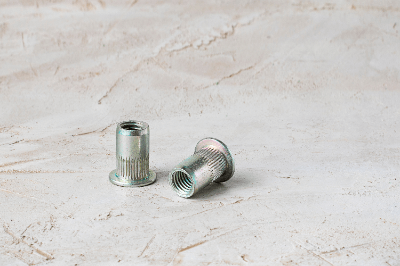What Is a Clinch Nut

When fastening two parts with a screw, a tap may be machined on the part facing each other to tighten the screw. However, when the mating part is a thin plate, it is impossible to process a tap that can withstand sufficient tightening force. Conventionally, a welding nut has been welded to a thin plate, but this requires man-hours to clean up welding stains and remove spatter from the nut threads, and cannot be used for aluminum, stainless steel, and resin parts, which are unsuitable for welding.
The clinch nut solves this problem by replacing the tapping process by simply machining a hole of the specified diameter in a thin plate that requires a tap and press-fitting a clinch nut of the required size into the hole.
Uses of Clinch Nuts
Clinch nuts are used in a wide variety of products that are constructed with sheet metal bodies and housings. These include personal computers and other home appliances, transportation equipment, including automobiles and vehicles, communication equipment, measuring instruments, and medical equipment. Applications for plastic parts where welding is not possible include clinch nuts for printed circuit boards.
Even when welding nuts can be welded, replacing them with clinch nuts is expected to reduce additional man-hours. In addition, if multiple press-fit heads are prepared, it is possible to automate the process to further reduce processing time.
Principle of Clinch Nuts
The clinch nut has a continuous stepped shape with three different diameters and widths: the head part, which is the widest and largest in diameter and has a threaded section inside, and plays the role of a conventional nut; a serrated section with knurled projections on the periphery, which is smaller in diameter and narrower in width than the head part, adjacent to the head part; and a serrated section with a press-fit hole adjacent to the serrated section. The serrated part has a smaller outer diameter and narrower width than the head, and the serrated part is adjacent to the serrated part and has an outer diameter equivalent to the press-fit hole diameter, with a slight reverse taper from the tip.
When the clinch nut is press-fitted into the target sheet, the serrated and reverse-tapered portions penetrate the sheet base material, so the clinch nut must be selected such that the total width of the serrated and reverse-tapered portions is less than or equal to the thickness of the target sheet.
The clinch nut is inserted into a hole in the sheet, and the sheet is supported to prevent deformation and the clinch nut is press-fitted into the sheet by a hand press. As the press-fitting progresses, the saw-tooth protrusions plastically deform the base material of the sheet metal, and the deformed part is pushed into the gap in the reverse taper section, and the press-fitting is completed when the end face of the head step strikes the sheet metal. The deformed base plate ensures the installation strength of the clinch nut in the direction of withdrawal and rotation.